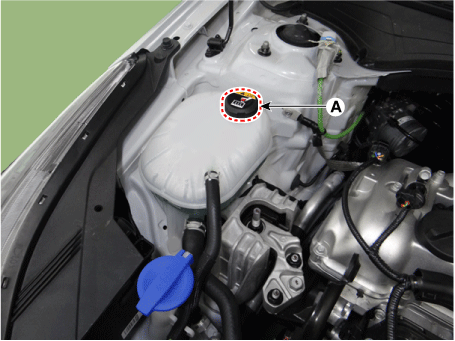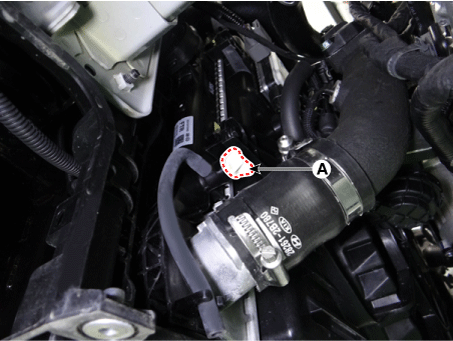Kia Forte: Cooling System / Coolant
Repair procedures
| Replacement And Air Bleeding |
Never remove the radiator cap when the engine is hot. Serious scalding could be caused by hot fluid under high pressure escaping from the radiator. |
When pouring engine coolant, be sure to shut the relay box lid and not to let coolant spill on the electrical parts or the paint. If any coolant spills, rinse it off immediately. |
| 1. |
Check that the engine and radiator are enough cool to touch with hands. |
| 2. |
Remove the radiator cap (A).
|
| 3. |
Remove the engine room under cover. (Refer to Engine and Transmission Assembly - "Engine Room Under Cover") |
| 4. |
Loosen the drain plug (A), and drain the coolant.
|
| 5. |
Tighten the radiator drain plug securely. |
| 6. |
After draining engine coolant in the reservoir tank, clean the tank. |
| 7. |
Fill the radiator with water through the radiator cap and tighten the cap.
|
| 8. |
Start the engine and allow to come to normal operating temperature. Wait for the cooling fans to turn on several times. Accelerate the engine to aid in purging trapped air. Shut engine off. |
| 9. |
Wait until the engine is cool. |
| 10. |
Repeat steps 1 to 8 until the drained water runs clear. |
| 11. |
Fill fluid mixture with coolant and water (55~60%) (Except for North America, Europe and China : 45~50%) slowly through the radiator cap. Push the upper/lower hoses of the radiator so as bleed air easily.
|
| 12. |
Start the engine and run until coolant circulates. When the cooling fan operates and coolant circulates, refill coolant through the radiator cap. |
| 13. |
Repeat step.11 until the cooling fan 3 ~ 5times and bleed air sufficiently out of the cooling system. |
| 14. |
Install the radiator cap and fill the reservoir tank to the "MAX" (or "F") line with coolant. |
| 15. |
Run the vehicle under idle until the cooling fan operates 2 ~ 3 times. |
| 16. |
Stop the engine and wait coolant gets cool. |
| 17. |
Repeat 10 to 15 until the coolant level doesn't fall any more, bleed air out of the cooling system.
|
 Cooling System
Cooling System
Components and components location
Components
1. Radiator
2. Radiator upper hose
3. Radiator lower hose
4. Filler neck assembly
5. Cooling fan
6. Radiato ...
 Reservoir Tank
Reservoir Tank
Repair procedures
Removal and Installation
1.
Disconnect the reservoir hose (A).
2.
Remove the reservoir tank (B).
Tightenin ...
Other information:
Kia Forte 2019-2025 (BD) Service Manual: Severe Condition
General market Maintenance Under Severe Usage Conditions - Except Europe (Including Russia) MAINTENANCE ITEM MAINTENANCE OPERATION MAINTENANCE INTERVALS DRIVING CONDITION Engine oil and engine oil filter ...
Kia Forte 2019-2025 (BD) Service Manual: Manual Transaxle
Components and components location Components 1. Control shaft complete 2. Manual transaxle case 3. Clutch housing 4. Back-up lamp switch 5. Manual transaxle support bracket 6. Control cable bracket Repair procedures Rem ...





